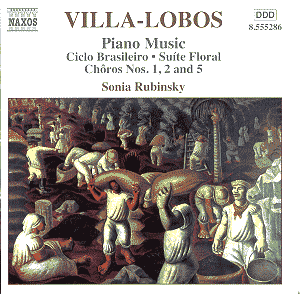Heitor Villa-Lobos
was a nationalist composer, not in the
nineteenth century sense of the word
(political patriotism), but in the early
twentieth century sense (preservation
of cultural heritage). In 1905, Villa-Lobos
began a series of travels around Brazil
to collect ideas from the folk music
of the regions. Like his colleagues
in Europe (Kodály, Bartók
and Stravinsky, for example) his music
began to reflect his discoveries, although
it is sometimes difficult to isolate
trends in his music, due to the sheer
volume of his output.
The music in this installment
comes from the first two decades of
the twentieth century, and runs the
gamut of styles and levels of difficulty.
The Suite Floral is a lovely
work, and the strong influence of the
French Impressionists is most evident
in these relatively obscure miniatures.
Critics and scholars regard the Ciclo
Brasileiro to be one of the composer’s
most important works for the piano.
Cast in four movements, this splendid
suite presents four snapshots of Brazilian
life and musical style. Perhaps most
memorable is the opening movement Plantio
do Cabolco, which through its ostinato
perpetuo in the right hand depicts
a peasant farmer casting seeds about
his field. In one of the first of many
works that was to focus on childhood
for its subject matter, the charming
Brinquedo de Roda (Children’s
round games) are based on melodies from
play-songs for children. These works
were very likely composed as teaching
pieces.
The Danças
Características Africanas
from 1915 were first heard in the 1922
"Week of Modern Art," and
came under a considerable critical attack.
They are based on Caripuna Indian songs,
and each piece represents a different
stage of life. Villa-Lobos’ series of
fourteen Chόros
written for various instrumental combinations
all of which reflect a different aspect
of Brazilian musical styles are perhaps
some of his best-known and significant
works. Only number five from the works
recorded here was originally for piano,
but they are all compelling in these
arrangements.
What first must be
said is that this is very attractive
and fresh music, varied in style and
rich in melodic content and rhythmic
interest. Although the influence of
other composers is often evident, particularly
Debussy in the Suite Floral and
Chopin in other places, this is work
that was obviously generated in a musical
mind of vast capacity.
Sonia Rubinsky is a
pianist with a completely solid technique,
and a keen sense of expression, grace,
humor and drama. One simply has to stop
and marvel that Naxos continues to find
exemplary artist after exemplary artist.
There are many technical demands made
of the pianist in this music, and regardless
of the work, be it the simple children’s
pieces Brinquedo de Roda to the
formidable virtuosity of the Ciclo
Brasileiro, whose opening movement
ostinato must be a wrist killer, Ms.
Rubinsky meets every demand with ease
and panache.
Without fail, this
disc meets one of the crucial demands
of a series: it makes one want to go
immediately to seek out the other volumes.
With excellent notes by James Melo,
and with some wonderfully atmospheric
sonic qualities, this disc is a winner
on all fronts. Yet more repertoire to
explore, yet another worthy addition
to the catalogue from Naxos. Bravo!
Kevin Sutton
see review of
Volume
2
